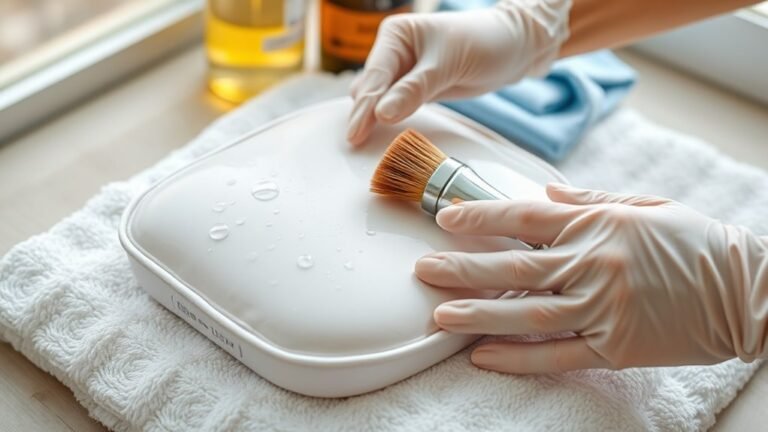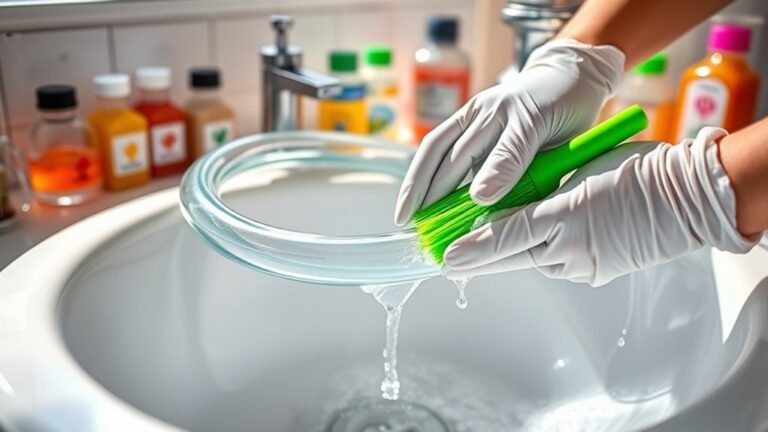How to Clean Camper Canvas
To clean your camper canvas, start with a thorough inspection for any tears or mildew. Gather a soft-bristle brush, mild soap, warm water, and a clean cloth. Mix the soap with warm water and gently scrub the fabric, focusing on stained areas. Rinse carefully to remove any soap residue. Always wear gloves, goggles, and a mask for safety. If you have tough stains, specialized cleaners can be spot-tested on inconspicuous areas for best results. You’ll discover more helpful tips ahead.
Preparation For Cleaning

Before you plunge into cleaning your camper canvas, it’s essential to gather the right tools and materials to guarantee effective results. Start with a thorough canvas inspection; check for any tears, mildew, or signs of wear. Identifying dirt types is important—whether it’s mud, bird droppings, or tree sap—since each requires different cleaning approaches. Take note of any areas that need special attention, as neglecting these can lead to further damage. Identify potential problem spots like seams or zippers, as these can harbor grime. Additionally, having a soft brush, sponge, and a bucket of warm water on hand will facilitate the cleaning process. This preparation guarantees you’re ready to tackle your canvas efficiently and effectively, preserving your freedom on the open road.
Tools and Chemical Required

To effectively clean your camper canvas, you’ll need a few essential tools and chemicals that can tackle various types of dirt and stains. Start with a soft-bristle brush and a bucket for mixing your solutions. You’ll also want a mild soap or canvas cleaner and a mildew treatment product specifically formulated for outdoor fabrics.
Here’s a quick reference table to guide you:
| Tool/Chemical | Purpose |
|---|---|
| Soft-bristle brush | Remove dirt and debris |
| Mild soap/canvas cleaner | General canvas cleaning |
| Mildew treatment | Address mold and mildew |
With these tools and chemicals, you’re well-equipped for effective canvas cleaning and mildew treatment, ensuring your camper stays ready for your next adventure.
How to Clean:

Step 1: Gather Your Cleaning Supplies
- Collect all necessary tools and materials before starting the cleaning process. This ensures you have everything on hand and can work efficiently.
- Required items include:
- Soft-bristle brush
- Mild soap or a specialized canvas cleaner
- Warm water
- Clean water for rinsing
- A clean cloth or sponge
- Bucket for mixing cleaning solution
Step 2: Choose Your Cleaning Technique
- Decide on the appropriate cleaning method based on the condition of your canvas.
- For most canvases, a mixture of warm water and mild soap is effective.
- If dealing with tougher stains, a specialized canvas cleaner may be necessary.
Step 3: Prepare the Cleaning Solution
- In a bucket, mix warm water with a small amount of mild soap to create a soapy solution.
- Ensure the soap is well-dissolved and not overly concentrated to avoid residue on the canvas.
Step 4: Scrub the Canvas
- Use the soft-bristle brush to gently scrub the fabric.
- Focus on stained or heavily soiled areas, applying a little extra pressure where needed but avoid damaging the fabric.
- Work in small sections to ensure thorough cleaning.
Step 5: Rinse Thoroughly
- After scrubbing, rinse the canvas thoroughly with clean water to remove any soap residue.
- This step is crucial, as leftover soap can attract dirt and could damage the canvas over time.
Step 6: Spot-Test for Tough Stains
- If you encounter stubborn stains, consider using a specialized canvas cleaner.
- Always conduct a spot test on a small, inconspicuous area first to ensure the cleaner doesn’t damage the fabric.
Step 7: Dry the Canvas
- Allow the canvas to dry completely in a well-ventilated area.
- Avoid exposing the canvas to direct sunlight as this can cause fading and damage to the material.
Step 8: Regular Maintenance
- To prolong the life of your canvas, regularly inspect it for dirt, mildew, or any signs of wear.
- Address any issues promptly to prevent them from worsening, ensuring your canvas remains in top condition for your next adventure.
Safety Consideration
While cleaning your camper canvas may seem straightforward, it’s crucial to prioritize safety throughout the process. Start by wearing appropriate safety gear, including gloves, goggles, and a mask, especially if you’re using chemical cleaners. This protects your skin, eyes, and respiratory system from harmful substances. When handling chemicals, always read labels carefully and follow the manufacturer’s instructions. Verify you’re in a well-ventilated area to minimize inhalation risks. If you’re using a ladder to access high areas of the canvas, make sure it’s stable and secure to prevent falls. Finally, keep a first-aid kit nearby, just in case of minor accidents. By following these safety considerations, you can enjoy a clean canvas while safeguarding your health and freedom on the road.
Frequently Asked Questions
How Often Should I Clean My Camper Canvas?
You should clean your camper canvas at least twice a year to maintain its longevity and performance. Curiously, neglecting regular cleaning can reduce its lifespan by nearly 50%. For ideal cleaning frequency, consider seasonal use and local conditions. Use maintenance tips like rinsing off dirt after trips, and avoid harsh chemicals. Keeping it clean not only protects your investment but also enhances your freedom to adventure without worry. Enjoy the open road with peace of mind!
Can I Use Bleach on Camper Canvas?
You shouldn’t use bleach on camper canvas, as it can damage the fabric and compromise its waterproofing. Instead, consider bleach alternatives like vinegar or mild soap for effective cleaning. For proper canvas care, mix a gentle solution and use a soft brush to scrub. Rinse thoroughly and allow it to dry completely. Maintaining your camper’s canvas not only preserves its lifespan but also guarantees your adventures remain worry-free and enjoyable.
Will Cleaning Damage the Waterproof Coating?
Cleaning your camper canvas can feel like walking a tightrope, but it doesn’t have to damage the waterproof coating if done right. Always use gentle cleaners and avoid harsh chemicals that can strip away the waterproof treatment. Regular canvas maintenance is key; after cleaning, consider reapplying a waterproofing spray to help restore its protective layer. This way, you can keep enjoying the great outdoors without worrying about leaks or damage!
What Should I Do if Mold Is Found?
If you find mold, act quickly. Start by mixing a solution of water and a gentle mold removal cleaning product. Test the solution on a small area first to verify it won’t damage the canvas. Use a soft brush to gently scrub the affected area, then rinse thoroughly with clean water. Allow it to dry completely before storing your camper. Regular checks can help prevent future mold growth, guaranteeing your freedom on the road.
How Can I Prevent Future Stains on the Canvas?
To keep your canvas as pristine as a knight’s armor, embrace preventive measures that shield it from stains. First, apply a stain-resistant treatment specifically designed for outdoor fabrics. Regularly inspect and clean your canvas to thwart potential dirt accumulation. Store your camper in a dry, ventilated space, avoiding prolonged exposure to the elements. By following these steps, you’ll guarantee your canvas remains a fortress, ready for your next adventure without unsightly blemishes.






